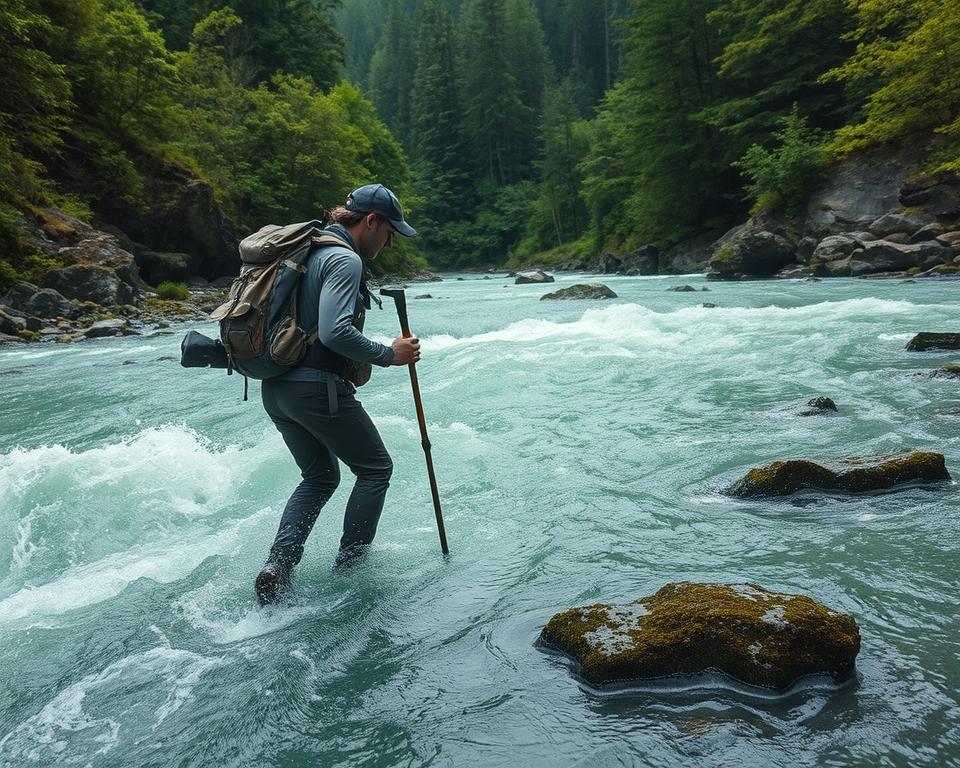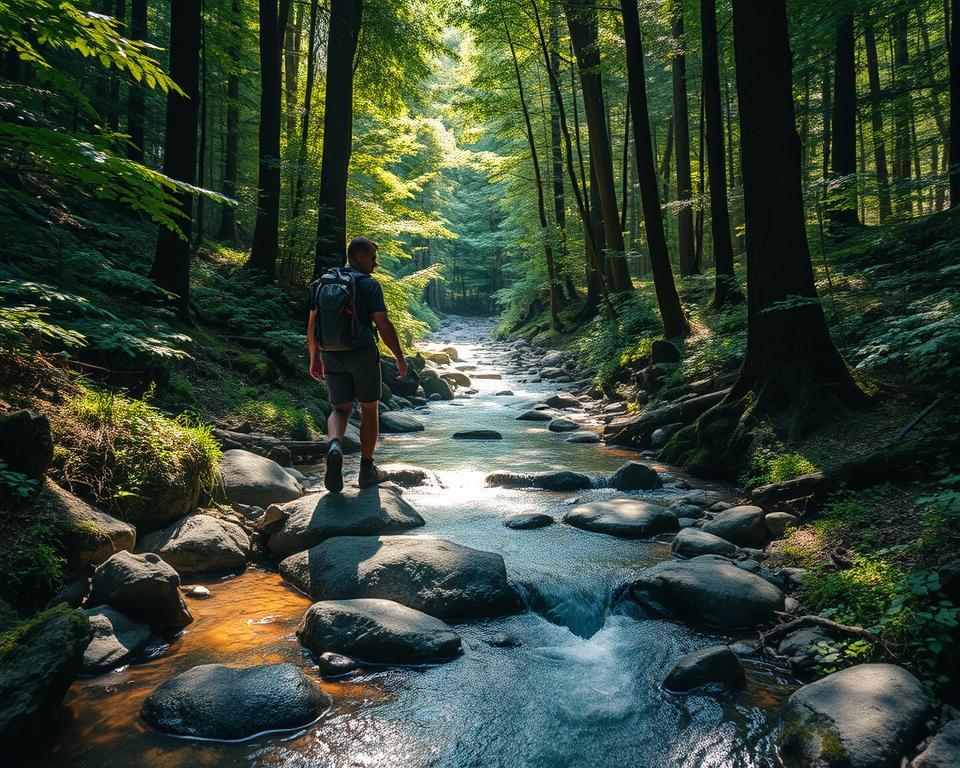River crossings are a major cause of accidents for hikers. It’s very important to know how to cross safely. This is especially true on trails like the John Muir Trail or the Pacific Crest Trail. Every year, sad events happen there. As an outdoor enthusiast, I’ve learned that crossing rivers safely requires good planning and skills.
One of my most nerve-wracking experiences was in New Zealand on the Te Araroa trail. I had to cross the same river over 30 times in a single day! Knowing the right hiking safety tips really helped. Now, let’s talk about how to do this safely and effectively.
Understanding When River Crossings Become Dangerous
Crossing a river while hiking takes more than muscle. It requires knowing how and being ready. By using the river check technique, I can tell if crossing is safe. I look at the river’s speed, depth, what the riverbed is like, and the weather forecast.
Checking Speed
To check a river’s speed, I throw a stick in to see how fast it floats away. If it moves quicker than you can walk, the river is too dangerous to cross. You need to know the water moves faster at different depths. The surface, pushed by wind, might not show the true danger below.
Checking Depth
Knowing how deep the water is vital for safety. Water above your knees increases the chance you’ll get swept away. For people hiking alone, like me, it’s risky to cross if water is deeper than your middle calf. In a group, you might safely cross water as deep as your mid-thigh. Using a trekking pole to feel the river’s depth is a smart trick.
Checking Bottom Conditions
The bottom of the river can make crossing safe or risky. A bottom that feels evenly rocky is best because it signals smaller, regular waves. Good shoes help you stay stable and safe from cuts. This makes crossing safer and lowers the chance of slipping.
Checking Weather Forecast
Always look at the weather before crossing rivers, especially those that grow from snow or ice melt. These rivers flow higher in the late day. I plan my crossings for the morning when it’s safer. Sudden rains can raise the water level quickly. So, you may need to wait or change your plans to stay safe.
Planning and Preparing for River Crossings
Proper planning is key for safe river crossings. It’s important because the risks are high. Preparing your hiking gear and assessing dangers can lower many risks. Let’s look at what you need for a safe river crossing.
Packing Essentials in Watertight Bags
It’s crucial to keep your gear dry. Make sure items like fire starters, sleeping bags, and clothes are in watertight bags. This step helps avoid losing important gear if you end up in the water.
Choosing Appropriate Footwear
Your shoe choice matters a lot for safety. Pick shoes that grip well and won’t come off in strong water. La Sportiva Akasha trail running shoes are known for their good stability and grip when wet.
Using Trekking Poles and Unclipping Your Pack
Trekking poles help you stay balanced, like having extra legs. Also, always unclip your pack before crossing. It makes it easier to get free if you fall, so you’re less likely to be pulled under.
Taking these steps seriously boosts your safety during river crossings. The right gear preparation, keeping things dry, choosing the right shoes, and using trekking poles can make a big difference.
How to Safely Cross Rivers While Hiking
River and stream crossings can be daunting for hikers. Yet, knowing a solid river crossing technique is key to staying safe. Keep these nine tips in mind as you go.
Scouting for Alternative Crossings
Looking for other ways to cross is crucial for safety. Check upstream and downstream from where the trail meets the river. Stay away from bends in the river, as they can hide dangers like shifting bottoms and faster water. If you spot a safer route, feel free to take it.
Crossing Techniques
There are safe techniques to cross rivers. Facing upstream with trekking poles helps keep your balance. This method ensures you have three points of contact with the riverbed at all times. Another method is the ‘string of pearls’, where hikers hold arms for better stability. Crossing via shorter rocks gives you more control. Also, opening your hip belt and sternum strap can prevent getting stuck if you fall.
Safety Tips for Solo and Group Crossings
Crossing in a group can make things safer. But solo hikers need to be even more cautious. If you’re alone and find a tough spot, try to cross with others. Always wait for company before crossing, and have a plan for emergencies. Shoes that dry quickly are best for crossing streams. Plus, wearing shoes or sandals is important to protect against sharp rocks.
Rivers can be dangerous and are a leading cause of death among hikers. Flash floods and quick changes make them risky. It’s essential to do your homework well, especially during the shoulder seasons when crossing can be harder. Always put your safety first, whether you’re hiking alone or in a group.
Dealing with Strong Currents and Deep Waters
Navigating rivers, especially with strong currents and deep waters, poses unique challenges. There are techniques to help you stay stable and safe. These are vital when crossing dangerous areas.
Facing Upstream and Shuffling Sideways
To deal with strong currents, face upstream and shuffle sideways. This way, you can control and fight against the water’s force. By doing this, your legs push forward without being swept away. It’s a top method for staying stable in deep water.

Assessing the Water’s Properties
Always check the water’s properties before crossing. Know the depth, flow speed, and the riverbed’s condition. I often use a stick or throw stones to understand the current and depth better. These steps are crucial to decide if it’s safe to cross.
Using a Rope for Added Safety
In strong currents, using a rope can add safety. When crossing in groups, a rope across the river helps everyone hold on. This makes crossing safer in powerful currents. It helps everyone cross safely in tough conditions.
What to Do If You Get Swept Away
Being swept away by water is scary. But, knowing what to do is key. It’s crucial to recognize safe places to get out and have the correct gear. These steps can keep you safe during sudden river problems.
Finding Safe Exit Points
It’s vital to identify emergency exits in a river. Before crossing, look at conditions downstream. Knowing where you can safely exit can save your life if caught by the current. Look for calm water and easy-to-reach banks. Always carry a map and know the area well.
Utilizing a Backpack Raft
Your backpack could save your life in an emergency. Learning water safety techniques is crucial. A backpack, with water-tight bags and loose straps, can become a temporary raft. It helps you stay afloat and survive with your backpack. Make sure your backpack is ready, with everything secure inside.
Being ready mentally and physically is important. For example, someone used an 8kg pack to help cross a river. In another case, a backpack kept someone afloat until they reached something firm. These skills are valuable to control the situation and reach safety.
Can I Safely Filter River Water After Crossing a River While Hiking?
When hiking, crossing a river can raise concerns about water safety. To safeguard your health, follow key tips for ensuring safe drinking water outdoors. Use a portable filter, boil water for at least one minute, or use purification tablets to eliminate harmful pathogens. Always prioritize your safety to enjoy nature worry-free.
Conclusion
Crossing rivers while hiking mixes fear and thrill. It requires us to respect nature’s power. This guide helps by showing how to safely cross rivers. It covers everything from checking the river’s speed and depth to how the weather can affect your plans.
We also revisited key river crossing strategies. Using trekking poles and the ‘Locking Arms Technique’ in groups boosts balance and support. The ‘Human Tripod Method’ and rope methods are great too. They add safety and control. But, it’s crucial to plan ahead. A good plan includes keeping gear dry, wearing proper shoes, and finding the best places to cross.
Knowing what to do if you’re swept away is key to avoiding danger. Finding safe places to exit the river and using a backpack as a raft can save your life. With this guide, you’ll be safer while enjoying hikes. These tips are good whether you hike alone or with friends. They help you enjoy nature safely.

